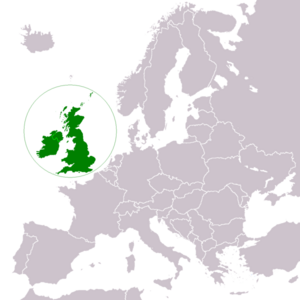British Isles
 From Citizendium - Reading time: 4 min
From Citizendium - Reading time: 4 min

The British Isles is a geographical term for a group of islands off the north-west coast of continental Europe. This north-east Atlantic archipelago comprises the very large islands of Great Britain and Ireland, together with more than 6,000 smaller islands.
The term has been considered at least mildly offensive by those with strong Irish nationalist views.[1] Other descriptions are also used, including "Great Britain and Ireland", "The British Isles and Ireland", "Britain and Ireland", and the deliberately vague "these isles", as well as other less common designations like "IONA" (Islands of the North Atlantic), "The Anglo-Celtic Isles", etc.
The isles extend from Pednathise Head, Isles of Scilly, in the south, to Out Stack, Shetland, in the north; and from Tearaght Island, Ireland, in the west, to Lowestoft Ness, England, in the east. There are more than 6,000 isles, amounting to a total land area of 121,674 square miles (315,134km²).
The British Isles are largely low-lying and fertile, though with significant mountainous areas in Ireland, Scotland, Wales, and the north of England. The regional geology is complex, formed by the drifting together of separate regions and subsequent orogenic, glacial and weathering activities.
Two sovereign states are located on the isles: the United Kingdom and Ireland.[2] The archipelago undoubtedly includes the Isle of Man, a British crown dependency; and some sources [1] [2] include the Channel Isles in the British Isles, although historically they are a Norman archipelago. Iceland and the Faeroe Isles were sometimes geographically associated, but have never been under British, Irish or Roman rule and are not today normally regarded as part of the British Isles.
Footnotes[edit]
- ↑ An Irishman's Diary Myers, Kevin; The Irish Times (subscription needed) 09/03/2000, Accessed July 2006 'millions of people from these islands — 'oh how angry we get when people call them the British Isles'
" Written Answers - Official Terms", Dáil Éireann - Volume 606 - 28 September, 2005. In his response, the Irish Minister for Foreign Affairs stated, "The British Isles is not an officially recognised term in any legal or inter-governmental sense. It is without any official status. The Government, including the Department of Foreign Affairs, does not use this term. Our officials in the Embassy of Ireland, London, continue to monitor the media in Britain for any abuse of the official terms as set out in the Constitution of Ireland and in legislation. These include the name of the State, the President, Taoiseach and others."
"New atlas lets Ireland slip shackles of Britain". A spokesman for the Irish Embassy in London said: “The British Isles has a dated ring to it, as if we are still part of the Empire. We are independent, we are not part of Britain [sic], not even in geographical terms. We would discourage its usage [sic].”
* "...I have called the Atlantic archipelago – since the term ‘British Isles’ is one which Irishmen reject and Englishmen decline to take quite seriously." Pocock, J.G.A. (2005). The Discovery of Islands. Cambridge: Cambridge University Press, p. 29.
"...what used to be called the "British Isles," although that is now a politically incorrect term." Finnegan, Richard B.; Edward T. McCarron (2000). Ireland: Historical Echoes, Contemporary Politics. Boulder: Westview Press, p. 358.
"In an attempt to coin a term that avoided the 'British Isles' - a term often offensive to Irish sensibilities - Pocock suggested a neutral geographical term for the collection of islands located off the northwest coast of continental Europe which included Britain and Ireland: the Atlantic archipelago..." Lambert, Peter; Phillipp Schofield (2004). Making History: An Introduction to the History and Practices of a Discipline. New York: Routledge, p. 217.
"..the term is increasingly unacceptable to Irish historians in particular, for whom the Irish sea is or ought to be a separating rather than a linking element. Sensitive to such susceptibilities, proponents of the idea of a genuine British history, a theme which has come to the fore during the last couple of decades, are plumping for a more neutral term to label the scattered islands peripheral to the two major ones of Great Britain and Ireland." Roots, Ivan (1997). "Union or Devolution in Cromwell's Britain". History Review.
Diarmaid MacCulloch, The Reformation: Europe's House Divided 1490-1700. (London: Penguin/Allen Lane, 2003): “the collection of islands which embraces England, Ireland, Scotland and Wales has commonly been known as the British Isles. This title no longer pleases all the inhabitants of the islands, and a more neutral description is ‘the Atlantic Isles’” (p. xxvi)
On 18 July 2004 The Sunday Business Post questioned the use of British Isles as a purely geographic expression, noting:[The] "Last Post has redoubled its efforts to re-educate those labouring under the misconception that Ireland is really just British. When British Retail Week magazine last week reported that a retailer was to make its British Isles debut in Dublin, we were puzzled. Is not Dublin the capital of the Republic of Ireland?...Archipelago of islands lying off the north-western coast of Europe?"
- ↑ The diplomatic and constitutional name of the Irish state is simply Ireland. For disambiguation purposes "Republic of Ireland" is often used though technically that is not the name of the state but, according to the Republic of Ireland Act 1948, its "description". Article 4, Bunreacht na hÉireann. Section 2, Republic of Ireland Act, 1948.
 KSF
KSF